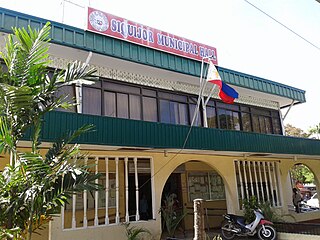
Balangiga, officially the Municipality of Balangiga, is a 4th class municipality in the province of Eastern Samar, Philippines. According to the 2020 census, it has a population of 14,341 people.

Dumaguete, officially the City of Dumaguete, and also known as Dumaguete City, is a 3rd income class component city and the capital of the province of Negros Oriental, Philippines. According to the 2020 census, it has a population of 134,103 people. It is the smallest in terms of land area yet the most populous among the cities and municipalities in the province of Negros Oriental.

Buenavista, officially the Municipality of Buenavista, is a 2nd class municipality and the largest settlement in the province of Guimaras, Philippines. According to the 2020 census, it has a population of 52,899 people.

Tanjay, officially the City of Tanjay, is a 4th class component city in the province of Negros Oriental, Philippines. According to the 2020 census, it has a population of 82,642 people.

Bindoy, officially the Municipality of Bindoy, is a 3rd class municipality in the province of Negros Oriental, Philippines. According to the 2020 census, it has a population of 40,308 people.

Dauin, officially the Municipality of Dauin is a 4th class municipality in the province of Negros Oriental, Philippines. According to the 2020 census, it has a population of 30,018 people.

Guihulngan, officially the City of Guihulngan, is a 5th class component city in the province of Negros Oriental, Philippines. According to the 2020 census, it has a population of 102,656 people, the third-most populous city in Negros Oriental after the cities of Dumaguete and Bayawan. Guihulngan is also dubbed by its residents as the "rising city of the north".

Manjuyod, officially the Municipality of Manjuyod, is a 2nd class municipality in the province of Negros Oriental, Philippines. According to the 2020 census, it has a population of 44,799 people.

Santa Catalina, officially the Municipality of Santa Catalina, is a 1st class municipality in the province of Negros Oriental, Philippines. According to the 2020 census, it has a population of 77,501 people.

Siaton, officially the Municipality of Siaton, is a 1st class municipality and the southernmost settlement in the province of Negros Oriental, Philippines. According to the 2020 census, it has a population of 83,082 people.

Sibulan, officially the Municipality of Sibulan, is a second class municipality in the province of Negros Oriental, Philippines. According to the 2020 census, it has a population of 64,343 people.

Tayasan, officially the Municipality of Tayasan, is a 3rd class municipality in the province of Negros Oriental, Philippines. According to the 2020 census, it has a population of 38,159 people.

Zamboanguita, officially the Municipality of Zamboanguita, is a 4th class municipality in the province of Negros Oriental, Philippines. According to the 2020 census, it has a population of 29,569 people.

Dumanjug, officially the Municipality of Dumanjug, is a 3rd class municipality in the province of Cebu, Philippines. According to the 2020 census, it has a population of 57,823 people.

Tuburan, officially the Municipality of Tuburan, is a 2nd class municipality in the province of Cebu, Philippines. According to the 2020 census, it has a population of 68,167 people.

Siquijor, officially the Municipality of Siquijor, is a 4th class municipality and capital of the province of Siquijor, Philippines. According to the 2020 census, it has a population of 28,915 people.

Binalbagan, officially the Municipality of Binalbagan, is a 1st class municipality in the province of Negros Occidental, Philippines. According to the 2020 census, it has a population of 71,407 people.

Culasi, officially the Municipality of Culasi, is a 3rd class municipality in the province of Antique, Philippines. According to the 2020 census, it has a population of 44,494 people. Making it fourth most populous municipality in the province of Antique and third largest municipality in terms of land area, with a total area of 228.56 square kilometers.

Candijay, officially the Municipality of Candijay, is a 4th class municipality in the province of Bohol, Philippines. According to the 2020 census, it has a population of 30,119 people.

Jiabong, officially the Municipality of Jiabong, is a 5th class municipality in the province of Samar, Philippines. According to the 2020 census, it has a population of 19,205 people.


























